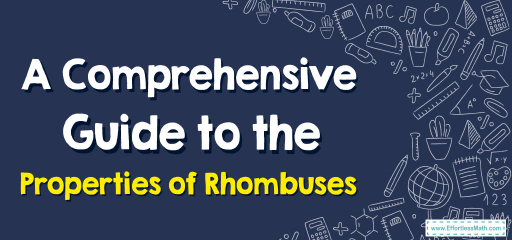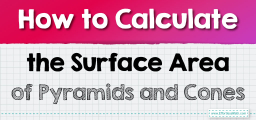A Comprehensive Guide to the Properties of Rhombuses
A rhombus, often viewed as a "slanted square," is a captivating quadrilateral that brings with it a set of distinctive properties. Every side of a rhombus is of equal length, making it a special type of parallelogram. While it shares some features with other parallelograms, its equilateral nature and intriguing internal angles make it a standout figure in geometry. As we delve deeper, we'll discover the rich geometric attributes and characteristics that make rhombuses both fascinating and fundamental in the realm of shapes.

Step-by-step Guide: Properties of The Rhombus
Definition of a Rhombus:
A rhombus is a four-sided polygon (quadrilateral) where all four sides are of equal length. This ensures that opposite angles of a rhombus are equal.
Parallel Opposite Sides:
The opposite sides of a rhombus are always parallel to each other, making it a type of parallelogram.
Equal Diagonals:
While the diagonals of a rhombus are not necessarily equal in length, they do bisect each other at right angles. This means that they divide each other into two equal parts.
Area:
The area of a rhombus can be determined using its diagonals. If \(d_1\) and \(d_2\) represent the lengths of the diagonals, then the area \(A\) is given by:
\( A = \frac{d_1 \times d_2}{2}\)
Perimeter:
As all sides of a rhombus are equal, if a side is of length \(s\), the perimeter \(P\) is:
\( P = 4s \)
Acute and Obtuse Angles:
A rhombus can have both acute and obtuse angles. The opposite angles are always equal. If one angle is acute, the angle adjacent to it will be obtuse, and vice versa.
Examples
Example 1:
Finding the Area of a Rhombus.
Given: A rhombus with diagonals measuring \(10\) units (longer diagonal) and \(8\) units (shorter diagonal).
Solution:
The area of a rhombus can be determined using the formula:
\(A = \frac{d_1 \times d_2}{2}\)
Where \(d_1\) and \(d_2\) are the lengths of the diagonals. Essentially, the area is half the product of its diagonals. This formula stems from the fact that the diagonals of a rhombus are perpendicular bisectors of each other, dividing the rhombus into four congruent right triangles.
Area: Using the formula, we get:
\( A = \frac{d_1 \times d_2}{2} = \frac{10 \times 8}{2} = 40 \) square
Example 2:
Calculating the Perimeter of a Rhombus.
Given: A rhombus with a side length of \(7\) units.
Solution:
The perimeter of a rhombus, or any polygon for that matter, is simply the sum of the lengths of its sides. Since all sides of a rhombus are of equal length, the perimeter can be calculated by multiplying one side by four.
Perimeter: Using the concept above, we find:
\( P = 4 \times \text{side length} = 4 \times 7 = 28 \) units
Practice Questions:
- A rhombus has diagonals measuring \(12\) units and \(16\) units. Compute its area.
- If one side of a rhombus is \(9\) units long, determine its perimeter.
- One diagonal of a rhombus is half the length of the other. If the longer diagonal is \(20\) units, find the area of the rhombus.

Answers:
- Area: \( A = \frac{12 \times 16}{2} = 96 \) square units.
- Perimeter: \( P = 4 \times 9 = 36 \) units.
- The shorter diagonal is \(10\) units. Area: \( A = \frac{20 \times 10}{2} = 100 \) square units.
Related to This Article
More math articles
- CBEST Test Facts and FAQs
- The Ultimate College Mathematics Placement Course (+FREE Worksheets & Tests)
- Tips for Learning Mathematics for the Humanitarians
- The Ultimate 6th Grade ILEARN Math Course (+FREE Worksheets)
- Mastering the Art of Integration: Vector-Valued Functions Explored
- Top 10 Tips to Create a CBEST Math Study Plan
- How to Get a GED Certificate?
- How is the PSAT/NMSQT Test Scored?
- Using Number Lines to Represent Integers
- How to Solve Word Problems on Dividing Whole Numbers by Unit Fractions


























What people say about "A Comprehensive Guide to the Properties of Rhombuses - Effortless Math: We Help Students Learn to LOVE Mathematics"?
No one replied yet.